Collections
java.util包下的Collections类,该类主要用于操作集合或者返回集合
一、排序
List<Integer> list = new ArrayList<>();list.add(2);list.add(1);list.add(3);Collections.sort(list);//升序System.out.println(list);Collections.reverse(list);//降序System.out.println(list);
二、获取最大或最小值
List<Integer> list = new ArrayList<>();
list.add(2);
list.add(1);
list.add(3);
Integer max = Collections.max(list);//获取最大值
Integer min = Collections.min(list);//获取最小值
System.out.println(max);
System.out.println(min);
三、转换线程安全集合
ArrayList、LinkedList、HashMap、HashSet等都是线程不安全的,这些集合在多线程的环境中,添加数据会出现异常
List<Integer> list = new ArrayList<>();list.add(2);list.add(1);list.add(3);List<Integer> integers = Collections.synchronizedList(list);//将ArrayList转换成线程安全集合System.out.println(integers);
它的底层会创建SynchronizedRandomAccessList或者SynchronizedList类,这两个类的很多方法都会用synchronized加锁
四、返回空集合
private List<Integer> fun(List<Integer> list) {if (list == null || list.size() == 0) {return Collections.emptyList();}//业务处理return list;
}
五、二分查找
binarySearch方法提供了一个非常好用的二分查找功能,只用传入指定集合和需要找到的key即可。
List<Integer> list = new ArrayList<>();
list.add(2);
list.add(1);
list.add(3);int i = Collections.binarySearch(list, 3);//二分查找
System.out.println(i );
六、 转换成不可修改集合
防止后续的程序把某个集合的结果修改了,有时候我们需要把某个集合定义成不可修改的,使用Collections的unmodifiablexxx方法就能轻松实现:
List<Integer> list = new ArrayList<>();
list.add(2);
list.add(1);
list.add(3);List<Integer> integers = Collections.unmodifiableList(list);
integers.add(4);
System.out.println(integers);
其他

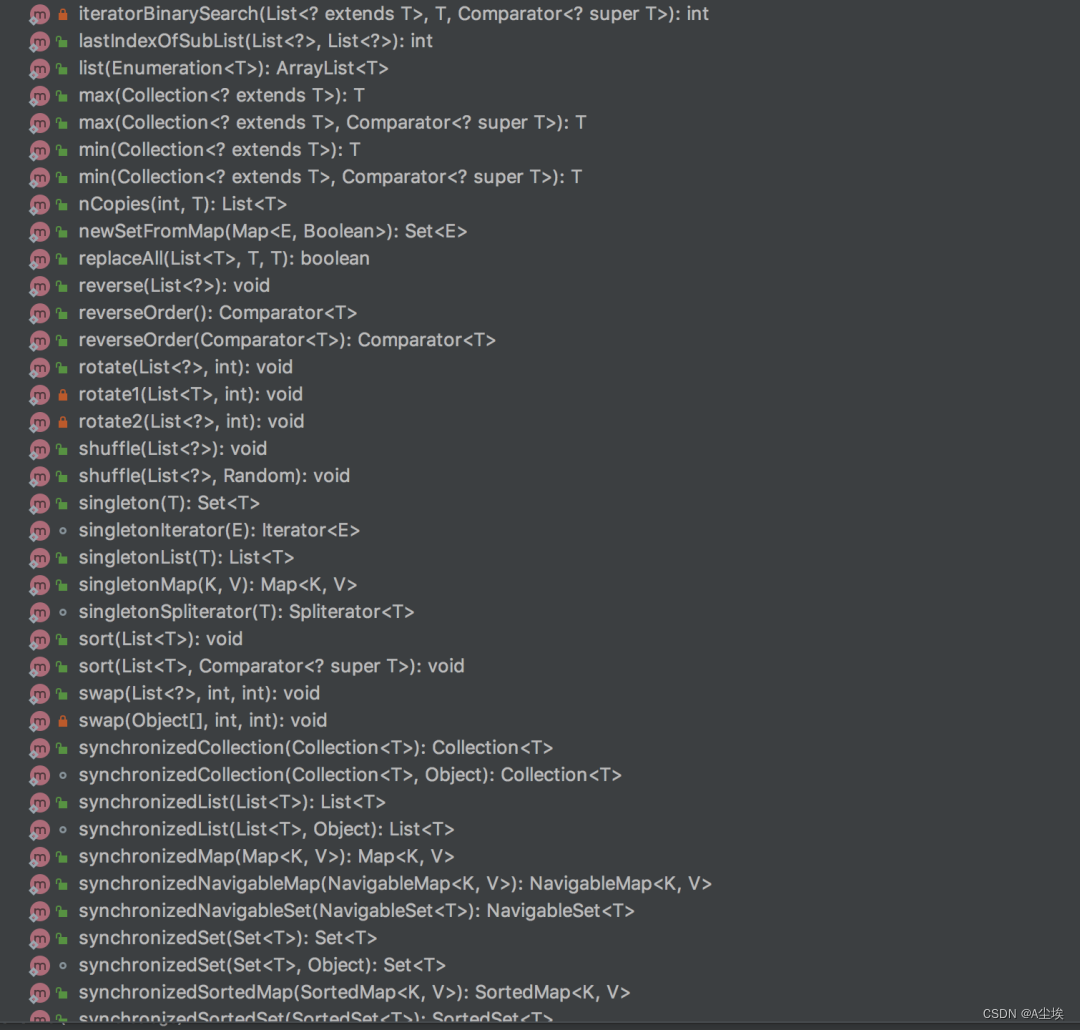
CollectionUtils
对集合操作,除了前面说的Collections工具类之后,CollectionUtils工具类也常用
目前比较主流的是spring的org.springframework.util包下的CollectionUtils工具类
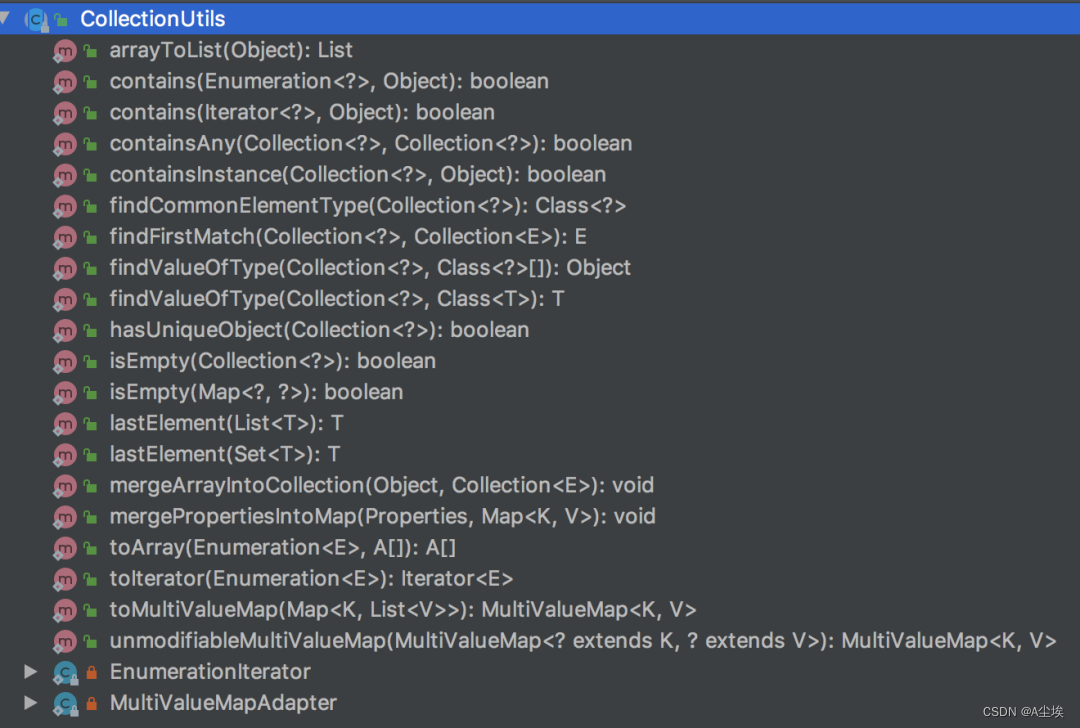
和apache的org.apache.commons.collections包下的CollectionUtils工具类。
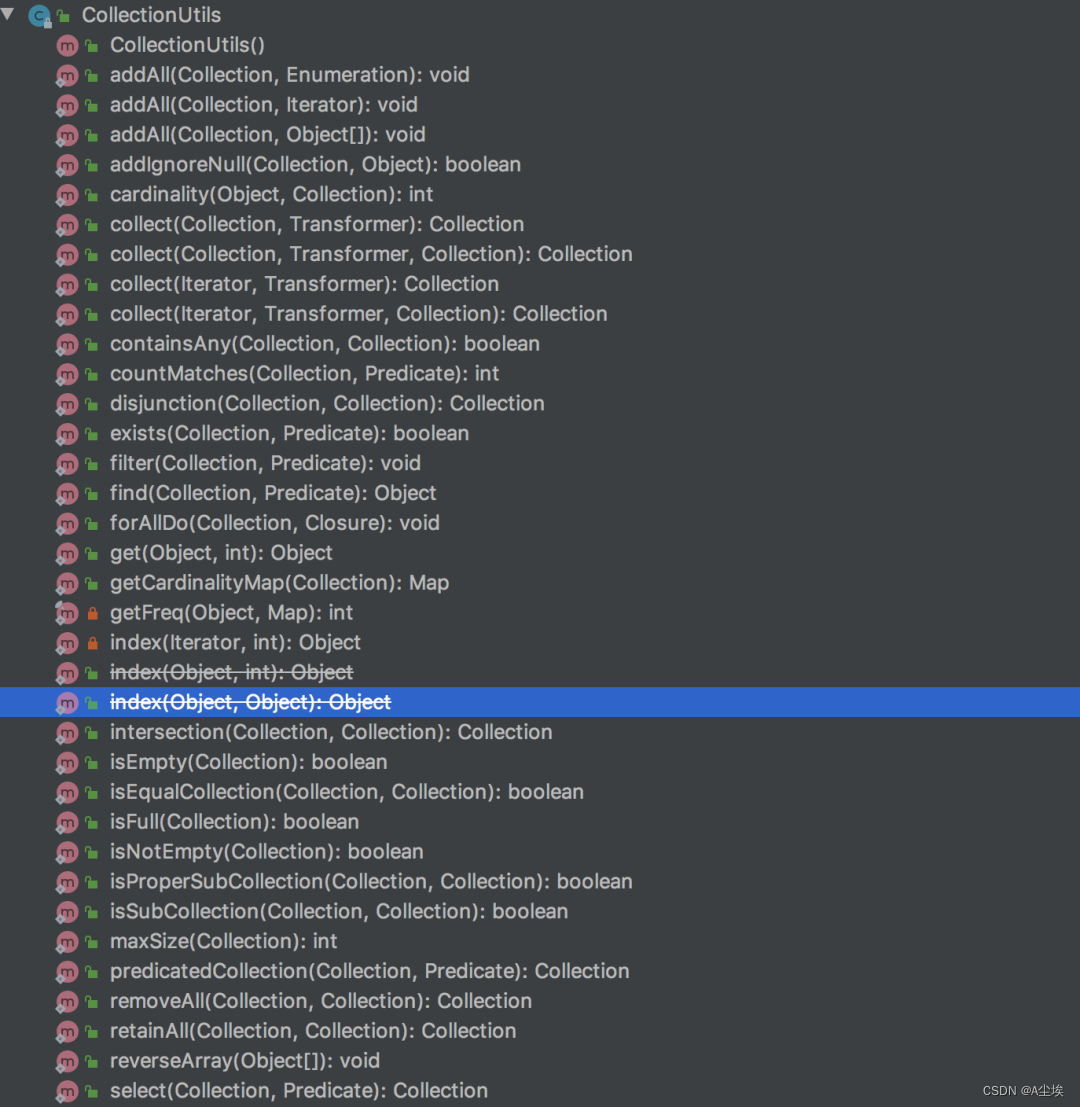
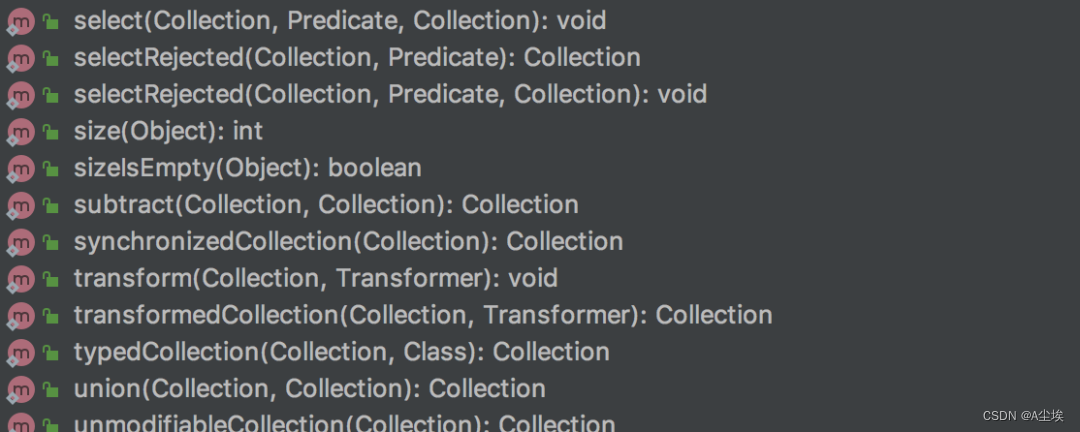
个人更推荐使用apache的包下的CollectionUtils工具类,因为它的工具更多更全面。
举个简单的例子,spring的CollectionUtils工具类没有判断集合不为空的方法。而apache的CollectionUtils工具类却有。
一、 集合判空
通过CollectionUtils工具类的isEmpty方法可以轻松判断集合是否为空,isNotEmpty方法判断集合不为空。
List<Integer> list = new ArrayList<>();
list.add(2);
list.add(1);
list.add(3);if (CollectionUtils.isEmpty(list)) {System.out.println("集合为空");
}if (CollectionUtils.isNotEmpty(list)) {System.out.println("集合不为空");
}
二、对两个集合进行操作
对已有的两个集合进行操作,比如取交集或者并集等
List<Integer> list = new ArrayList<>();
list.add(2);
list.add(1);
list.add(3);List<Integer> list2 = new ArrayList<>();
list2.add(2);
list2.add(4);//获取并集
Collection<Integer> unionList = CollectionUtils.union(list, list2);
System.out.println(unionList);//获取交集
Collection<Integer> intersectionList = CollectionUtils.intersection(list, list2);
System.out.println(intersectionList);//获取交集的补集
Collection<Integer> disjunctionList = CollectionUtils.disjunction(list, list2);
System.out.println(disjunctionList);//获取差集
Collection<Integer> subtractList = CollectionUtils.subtract(list, list2);
System.out.println(subtractList);
Lists
引入com.google.guava的pom文件,会获得很多好用的小工具。这里推荐一款com.google.common.collect包下的集合工具:Lists‘
一、快速初始化集合
List<Integer> list = Lists.newArrayList(1, 2, 3);
二、笛卡尔积
List<Integer> list1 = Lists.newArrayList(1, 2, 3);
List<Integer> list2 = Lists.newArrayList(4,5);
List<List<Integer>> productList = Lists.cartesianProduct(list1,list2);
System.out.println(productList);
三、分页
将一个大集合分成若干个小集合
//list有5条数据,我将list集合按大小为2,分成了3页,即变成3个小集合。
List<Integer> list = Lists.newArrayList(1, 2, 3, 4, 5);
List<List<Integer>> partitionList = Lists.partition(list, 2);
System.out.println(partitionList);
比如有个需求:现在有5000个id,需要调用批量用户查询接口,查出用户数据。但如果你直接查5000个用户,单次接口响应时间可能会非常慢。如果改成分页处理,每次只查500个用户,异步调用10次接口,就不会有单次接口响应慢的问题。
四、流处理
把某个集合转换成另外一个接口,可以使用Lists的transform方法
//将小写字母转换成了大写字母
List<String> list = Lists.newArrayList("a","b","c");
List<String> transformList = Lists.transform(list, x -> x.toUpperCase());
System.out.println(transformList);
五、颠倒顺序
List<Integer> list = Lists.newArrayList(3, 1, 2);
List<Integer> reverseList = Lists.reverse(list);
System.out.println(reverseList);
其他

Objects
在jdk7之后,提供了Objects工具类,我们可以通过它操作对象。
一、对象判空
Integer integer = new Integer(1);if (Objects.isNull(integer)) {System.out.println("对象为空");
}if (Objects.nonNull(integer)) {System.out.println("对象不为空");
}
二、对象为空抛异常
Integer integer1 = new Integer(128);Objects.requireNonNull(integer1);
Objects.requireNonNull(integer1, "参数不能为空");
Objects.requireNonNull(integer1, () -> "参数不能为空");
三、判断段两个对象是否相等
Integer integer1 = new Integer(1);
Integer integer2 = new Integer(1);System.out.println(Objects.equals(integer1, integer2)); //true//但改成
Integer integer1 = new Integer(1);
Long integer2 = new Long(1);System.out.println(Objects.equals(integer1, integer2));//false
四、获取对象的hashCode
获取某个对象的hashCode,可以使用Objects的hashCode方法
String str = new String("abc");
System.out.println(Objects.hashCode(str));
其他
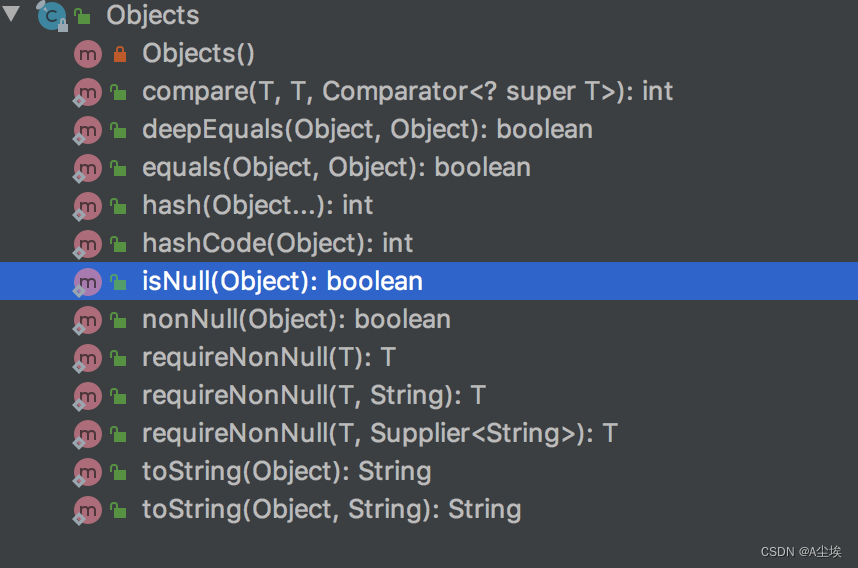
BooleanUtils
一、判断true或false
Boolean aBoolean = new Boolean(true);
System.out.println(BooleanUtils.isTrue(aBoolean));
System.out.println(BooleanUtils.isFalse(aBoolean));
二、判断不为true或不为false
需要判断某个参数不为true,即是null或者false。或者判断不为false,即是null或者true
Boolean aBoolean = new Boolean(true);
Boolean aBoolean1 = null;
System.out.println(BooleanUtils.isNotTrue(aBoolean));
System.out.println(BooleanUtils.isNotTrue(aBoolean1));
System.out.println(BooleanUtils.isNotFalse(aBoolean));
System.out.println(BooleanUtils.isNotFalse(aBoolean1));
三、转换成数字
Boolean aBoolean = new Boolean(true);
Boolean aBoolean1 = new Boolean(false);
System.out.println(BooleanUtils.toInteger(aBoolean));
System.out.println(BooleanUtils.toInteger(aBoolean1));
四、Boolean转换成布尔值
Boolean aBoolean = new Boolean(true);
Boolean aBoolean1 = null;
System.out.println(BooleanUtils.toBoolean(aBoolean));
System.out.println(BooleanUtils.toBoolean(aBoolean1));
System.out.println(BooleanUtils.toBooleanDefaultIfNull(aBoolean1, false));
无需额外的判空了,而且还可以设置Boolean对象为空时返回的默认值
其他

StringUtils
一、字符串判空
isEmpty、isNotEmpty、isBlank和isNotBlank,这4个判空方法你们可以根据实际情况使用
String str1 = null;
String str2 = "";
String str3 = " ";
String str4 = "abc";
System.out.println(StringUtils.isEmpty(str1));
System.out.println(StringUtils.isEmpty(str2));
System.out.println(StringUtils.isEmpty(str3));
System.out.println(StringUtils.isEmpty(str4));
System.out.println("=====");
System.out.println(StringUtils.isNotEmpty(str1));
System.out.println(StringUtils.isNotEmpty(str2));
System.out.println(StringUtils.isNotEmpty(str3));
System.out.println(StringUtils.isNotEmpty(str4));
System.out.println("=====");
System.out.println(StringUtils.isBlank(str1));
System.out.println(StringUtils.isBlank(str2));
System.out.println(StringUtils.isBlank(str3));
System.out.println(StringUtils.isBlank(str4));
System.out.println("=====");
System.out.println(StringUtils.isNotBlank(str1));
System.out.println(StringUtils.isNotBlank(str2));
System.out.println(StringUtils.isNotBlank(str3));
System.out.println(StringUtils.isNotBlank(str4));
二、分隔字符串
使用StringUtils的split方法会返回null,而使用String的split方法会报指针异常。
String str1 = null;
System.out.println(StringUtils.split(str1,","));
System.out.println(str1.split(","));
三、判断是否纯数字
给定一个字符串,判断它是否为纯数字,可以使用isNumeric方法。例如:
String str1 = "123";
String str2 = "123q";
String str3 = "0.33";
System.out.println(StringUtils.isNumeric(str1));
System.out.println(StringUtils.isNumeric(str2));
System.out.println(StringUtils.isNumeric(str3));
四、将集合拼接成字符串
将某个集合的内容,拼接成一个字符串,然后输出
List<String> list = Lists.newArrayList("a", "b", "c");
List<Integer> list2 = Lists.newArrayList(1, 2, 3);
System.out.println(StringUtils.join(list, ","));
System.out.println(StringUtils.join(list2, " "));
其他
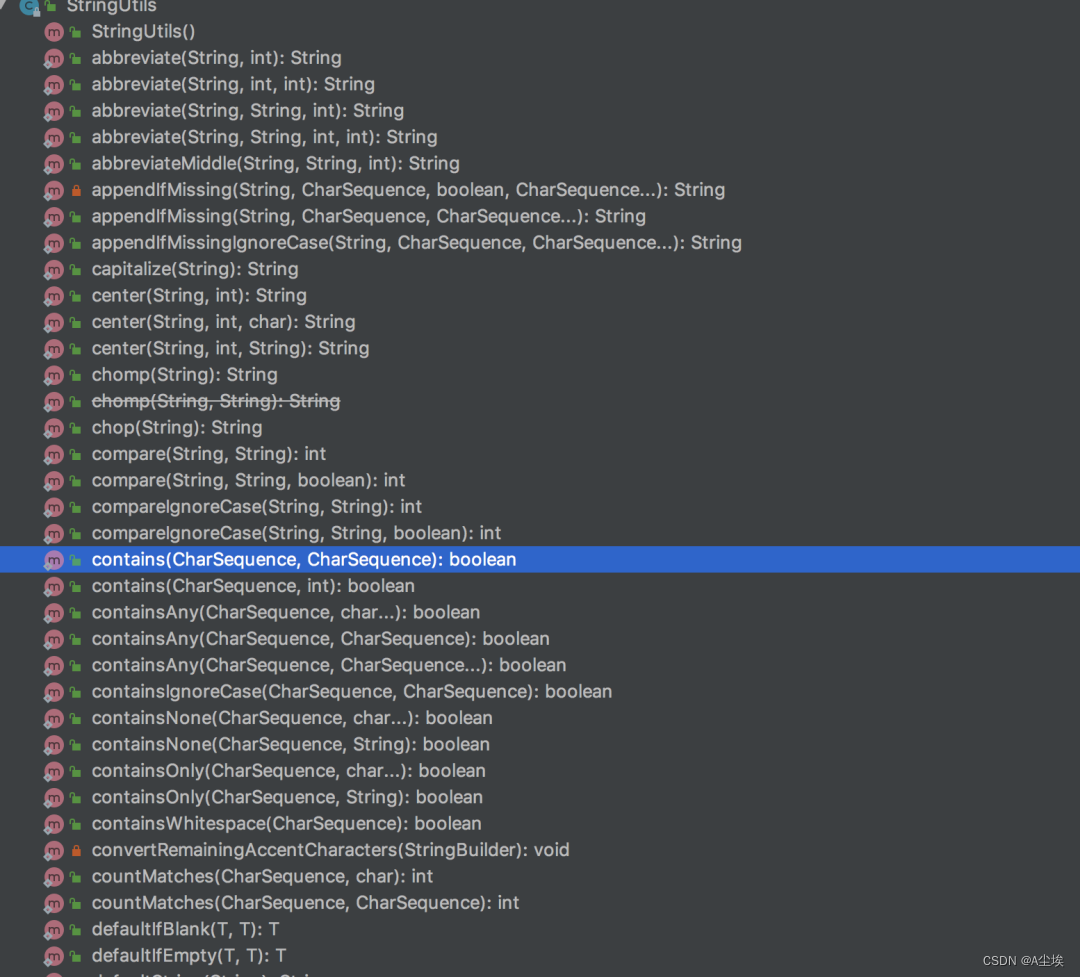
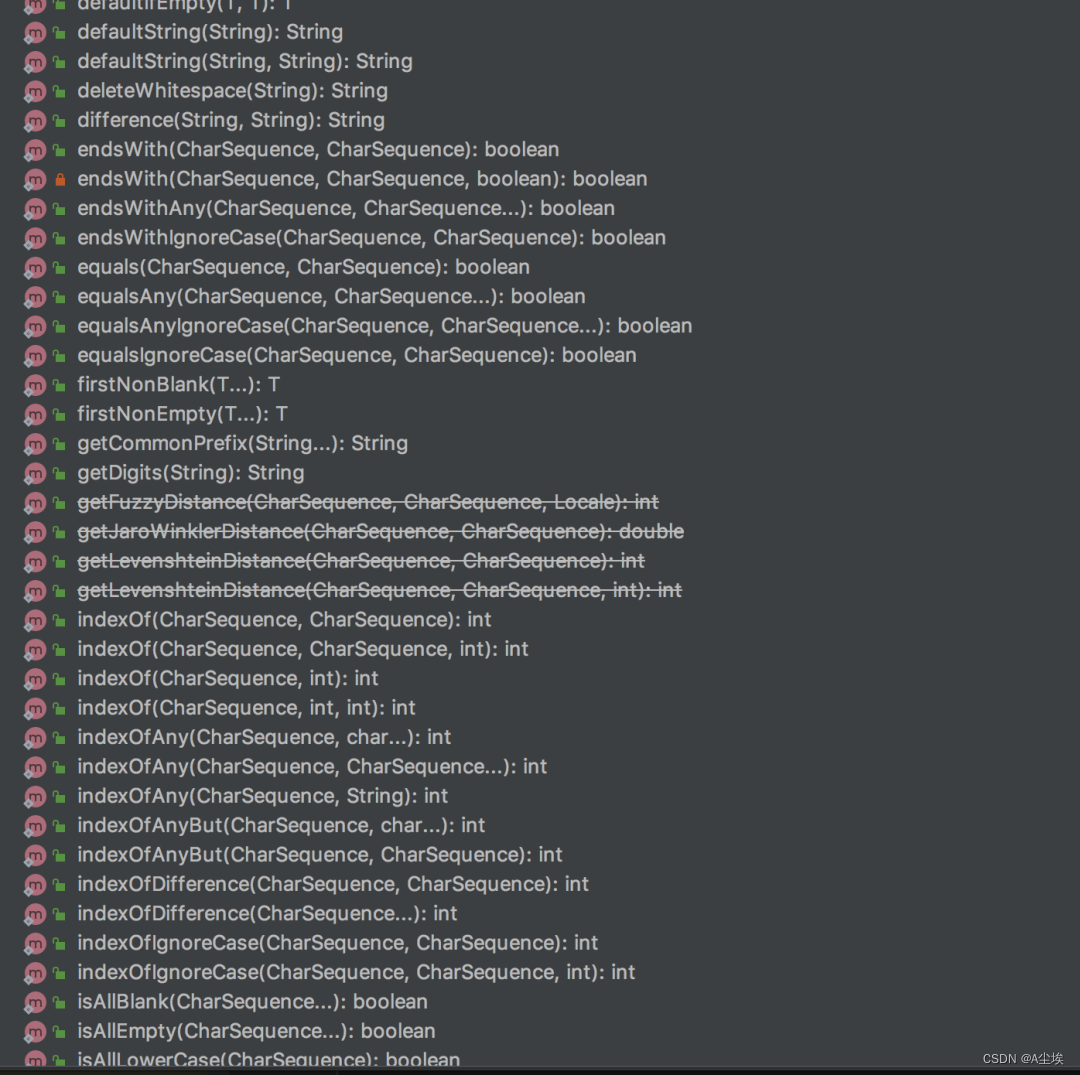
Assert
一、断言参数是否为空
断言参数是否空,如果不满足条件,则直接抛异常,如果不满足条件就会抛出IllegalArgumentException异常
String str = null;
Assert.isNull(str, "str必须为空");
Assert.isNull(str, () -> "str必须为空");
Assert.notNull(str, "str不能为空");
二、断言集合是否为空
断言集合是否空,如果不满足条件,则直接抛异常。如果不满足条件就会抛出IllegalArgumentException异常。
List<String> list = null;
Map<String, String> map = null;
Assert.notEmpty(list, "list不能为空");
Assert.notEmpty(list, () -> "list不能为空");
Assert.notEmpty(map, "map不能为空");
三、断言条件是否为空
断言是否满足某个条件,如果不满足条件,则直接抛异常
List<String> list = null;
Assert.isTrue(CollectionUtils.isNotEmpty(list), "list不能为空");
Assert.isTrue(CollectionUtils.isNotEmpty(list), () -> "list不能为空");
其他

IOUtils
一、读取文件
将某个txt文件中的数据,读取到字符串当中,可以使用IOUtils类的toString方法。
String str = IOUtils.toString(new FileInputStream("/temp/a.txt"), StandardCharsets.UTF_8);
System.out.println(str);
二、写入文件
将某个字符串的内容,写入到指定文件当中,可以使用IOUtils类的write方法
String str = "abcde";
IOUtils.write(str, new FileOutputStream("/temp/b.tx"), StandardCharsets.UTF_8);
三、文件拷贝
将某个文件中的所有内容,都拷贝到另一个文件当中,可以使用IOUtils类的copy方法。
IOUtils.copy(new FileInputStream("/temp/a.txt"), new FileOutputStream("/temp/b.txt"));
四、读取文件内容到字节数组
将某个文件中的内容,读取字节数组中,可以使用IOUtils类的toByteArray
byte[] bytes = IOUtils.toByteArray(new FileInputStream("/temp/a.txt"));
其他

MDC
MDC是org.slf4j包下的一个类,它的全称是Mapped Diagnostic Context,我们可以认为它是一个线程安全的存放诊断日志的容器。
底层是用了ThreadLocal来保存数据的。
使用RestTemplate调用远程接口时,有时需要在header中传递信息,比如:traceId,source等,便于在查询日志时能够串联一次完整的请求链路,快速定位问题。
这种业务场景就能通过ClientHttpRequestInterceptor接口实现,具体做法如下:
①、定义一个LogFilter拦截所有接口请求,在MDC中设置traceId:
public class LogFilter implements Filter {@Overridepublic void init(FilterConfig filterConfig) throws ServletException {}@Overridepublic void doFilter(ServletRequest request, ServletResponse response, FilterChain chain) throws IOException, ServletException {MdcUtil.add(UUID.randomUUID().toString());System.out.println("记录请求日志");chain.doFilter(request, response);System.out.println("记录响应日志");}@Overridepublic void destroy() {}
}
②、实现ClientHttpRequestInterceptor接口,MDC中获取当前请求的traceId,然后设置到header中:
public class RestTemplateInterceptor implements ClientHttpRequestInterceptor {@Overridepublic ClientHttpResponse intercept(HttpRequest request, byte[] body, ClientHttpRequestExecution execution) throws IOException {request.getHeaders().set("traceId", MdcUtil.get());return execution.execute(request, body);}
}
③、定义配置类,配置上面定义的RestTemplateInterceptor类:
@Configuration
public class RestTemplateConfiguration {@Beanpublic RestTemplate restTemplate() {RestTemplate restTemplate = new RestTemplate();restTemplate.setInterceptors(Collections.singletonList(restTemplateInterceptor()));return restTemplate;}@Beanpublic RestTemplateInterceptor restTemplateInterceptor() {return new RestTemplateInterceptor();}
}
其中MdcUtil其实是利用MDC工具在ThreadLocal中存储和获取traceId
public class MdcUtil {private static final String TRACE_ID = "TRACE_ID";public static String get() {return MDC.get(TRACE_ID);}public static void add(String value) {MDC.put(TRACE_ID, value);}
}
当然,这个例子中没有演示MdcUtil类的add方法具体调的地方,我们可以在filter中执行接口方法之前,生成traceId,调用MdcUtil类的add方法添加到MDC中,然后在同一个请求的其他地方就能通过MdcUtil类的get方法获取到该traceId。
能使用MDC保存traceId等参数的根本原因是,用户请求到应用服务器,Tomcat会从线程池中分配一个线程去处理该请求。
那么该请求的整个过程中,保存到MDC的ThreadLocal中的参数,也是该线程独享的,所以不会有线程安全问题。
ClassUtils
spring的org.springframework.util包下的ClassUtils类
一、获取对象的所有接口
Class<?>[] allInterfaces = ClassUtils.getAllInterfaces(new User());
二、获取某个类的包名
String packageName = ClassUtils.getPackageName(User.class);
System.out.println(packageName);
三、判断某个类是否内部类
System.out.println(ClassUtils.isInnerClass(User.class));
四、判断对象是否代理对象
判断对象是否代理对象,可以使用ClassUtils的isCglibProxy方法
System.out.println(ClassUtils.isCglibProxy(new User()));
其他
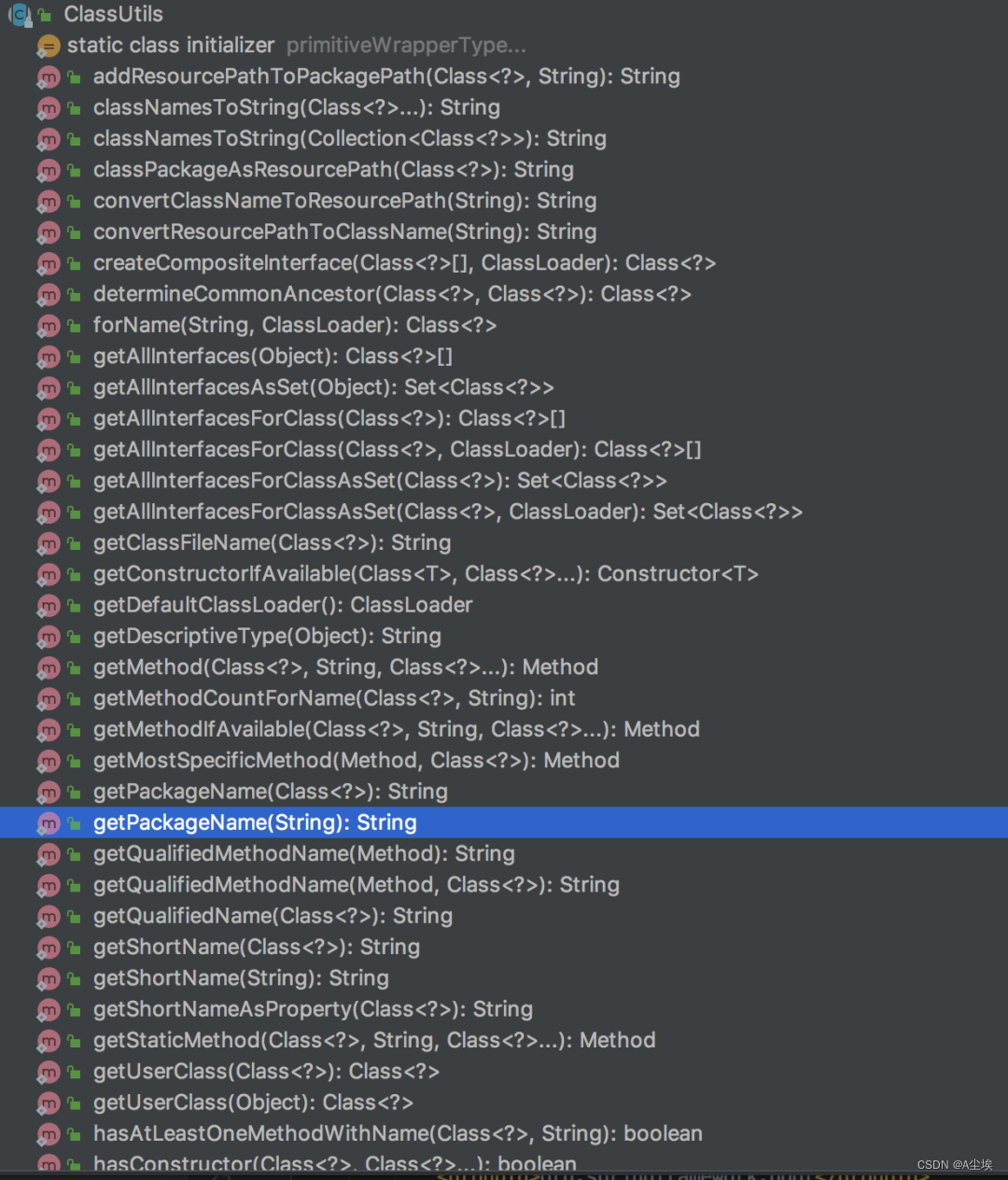
BeanUtils
在org.springframework.beans包下面
一、拷贝对象的属性
把某个对象中的所有属性,都拷贝到另外一个对象中
User user1 = new User();
user1.setId(1L);
user1.setName("苏三说技术");
user1.setAddress("成都");User user2 = new User();
BeanUtils.copyProperties(user1, user2);
System.out.println(user2);
二、实例化某个类
通过反射实例化一个类的对象
User user = BeanUtils.instantiateClass(User.class);
System.out.println(user);
三、获取指定类的指定方法
Method declaredMethod = BeanUtils.findDeclaredMethod(User.class, "getId");
System.out.println(declaredMethod.getName());
四、获取指定方法的参数
Method declaredMethod = BeanUtils.findDeclaredMethod(User.class, "getId");
PropertyDescriptor propertyForMethod = BeanUtils.findPropertyForMethod(declaredMethod);
System.out.println(propertyForMethod.getName());
其他
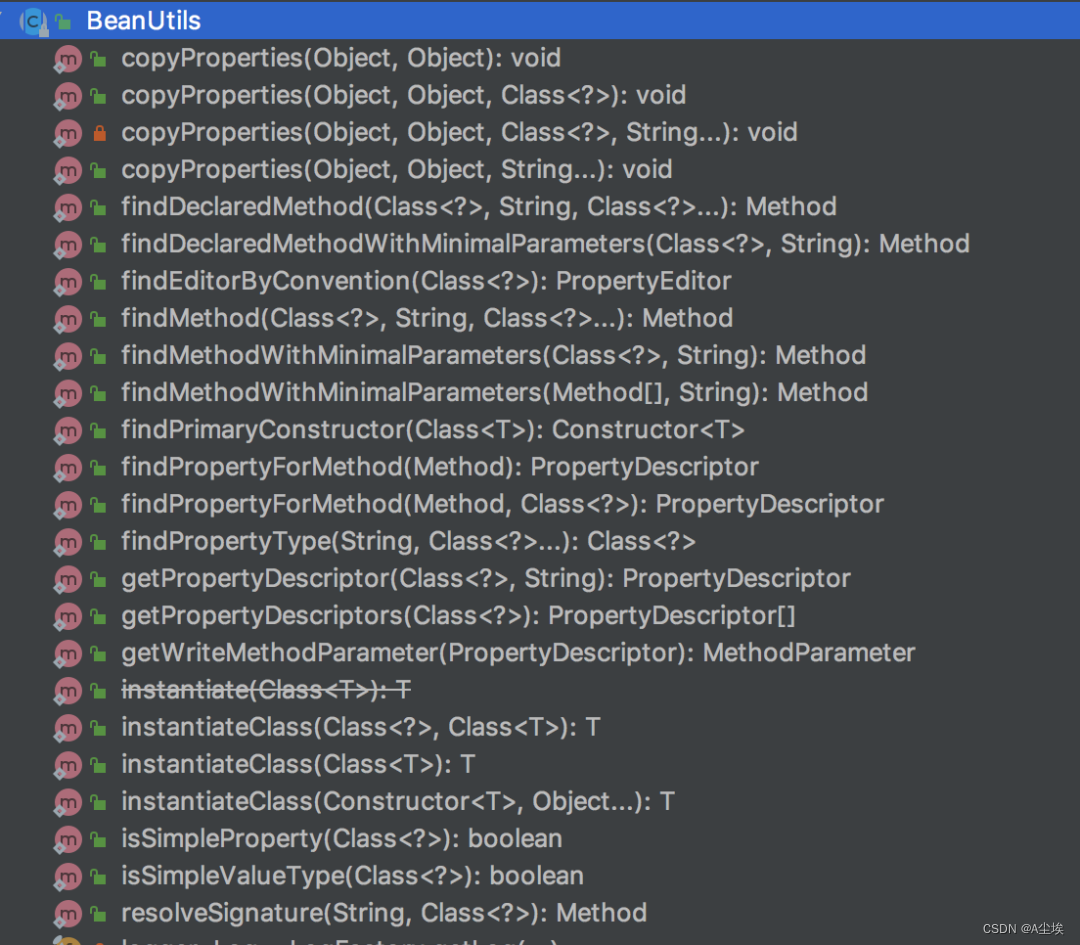
ReflectionUtils
一、获取方法
Method method = ReflectionUtils.findMethod(User.class, "getId");
二、获取字段
Field field = ReflectionUtils.findField(User.class, "id");
三、执行方法
ReflectionUtils.invokeMethod(method, springContextsUtil.getBean(beanName), param);
四、判断字段是否常量
Field field = ReflectionUtils.findField(User.class, "id");
System.out.println(ReflectionUtils.isPublicStaticFinal(field));
五、判断是否equals方法
Method method = ReflectionUtils.findMethod(User.class, "getId");
System.out.println(ReflectionUtils.isEqualsMethod(method));
其他
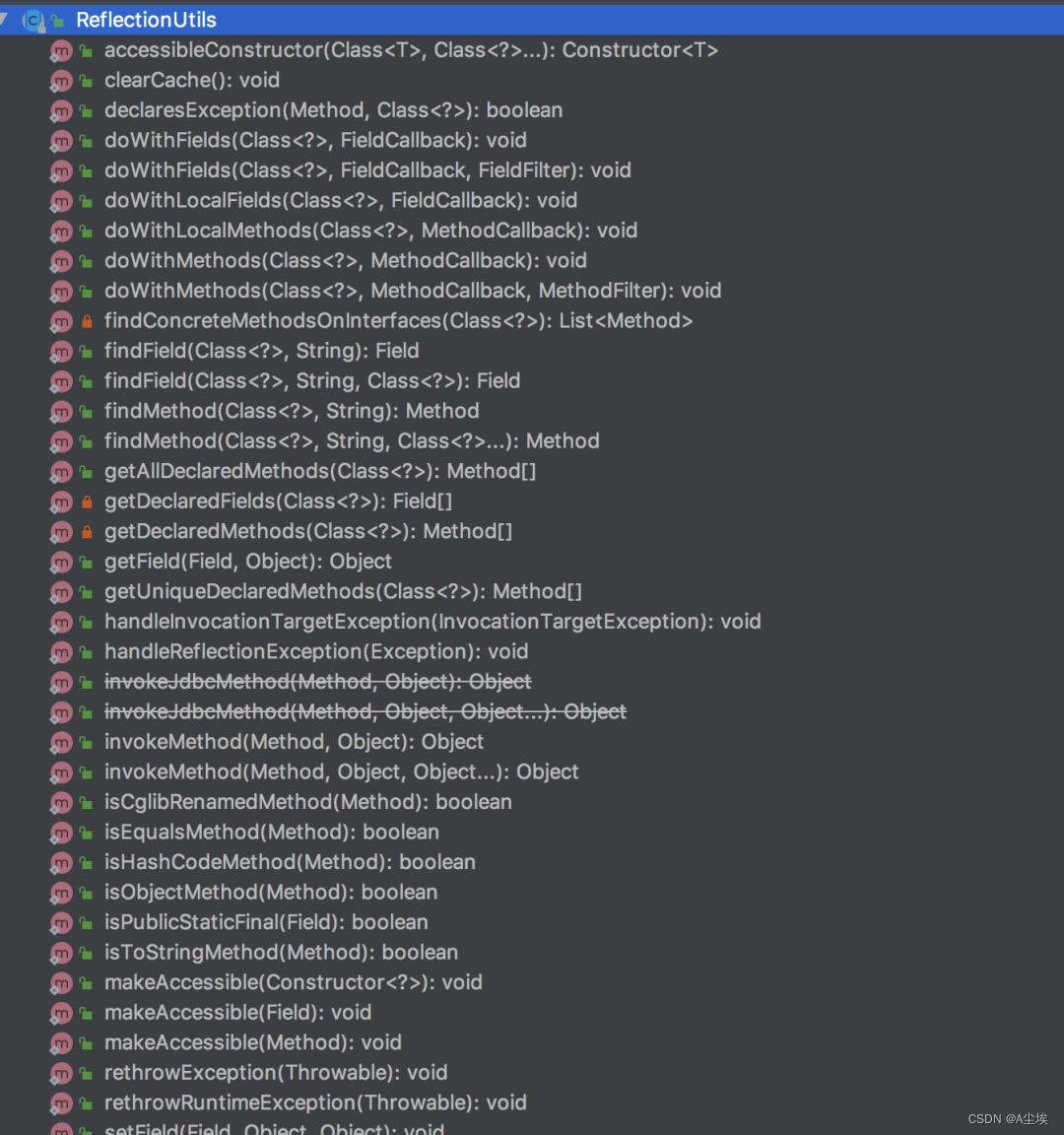
Base64Utils
直接使用org.springframework.util包下的Base64Utils工具类
encode和decode方法,用于对数据进行加密和解密
String str = "abc";
String encode = new String(Base64Utils.encode(str.getBytes()));
System.out.println("加密后:" + encode);
try {String decode = new String(Base64Utils.decode(encode.getBytes()), "utf8");System.out.println("解密后:" + decode);
} catch (UnsupportedEncodingException e) {e.printStackTrace();
}
StandardCharsets
做字符转换的时候,经常需要指定字符编码,比如:UTF-8、ISO-8859-1等等
使用java.nio.charset包下的StandardCharsets类中静态变量
String str = "abc";
String encode = new String(Base64Utils.encode(str.getBytes()));
System.out.println("加密后:" + encode);
String decode = new String(Base64Utils.decode(encode.getBytes())
, StandardCharsets.UTF_8);
System.out.println("解密后:" + decode);
DigestUtils
对数据进行加密处理,比如:md5或sha256
使用apache的org.apache.commons.codec.digest包下的DigestUtils类
一、 md5加密
String md5Hex = DigestUtils.md5Hex("苏三说技术");
System.out.println(md5Hex);
二、sha256加密
String md5Hex = DigestUtils.sha256Hex("苏三说技术");
System.out.println(md5Hex);
其他
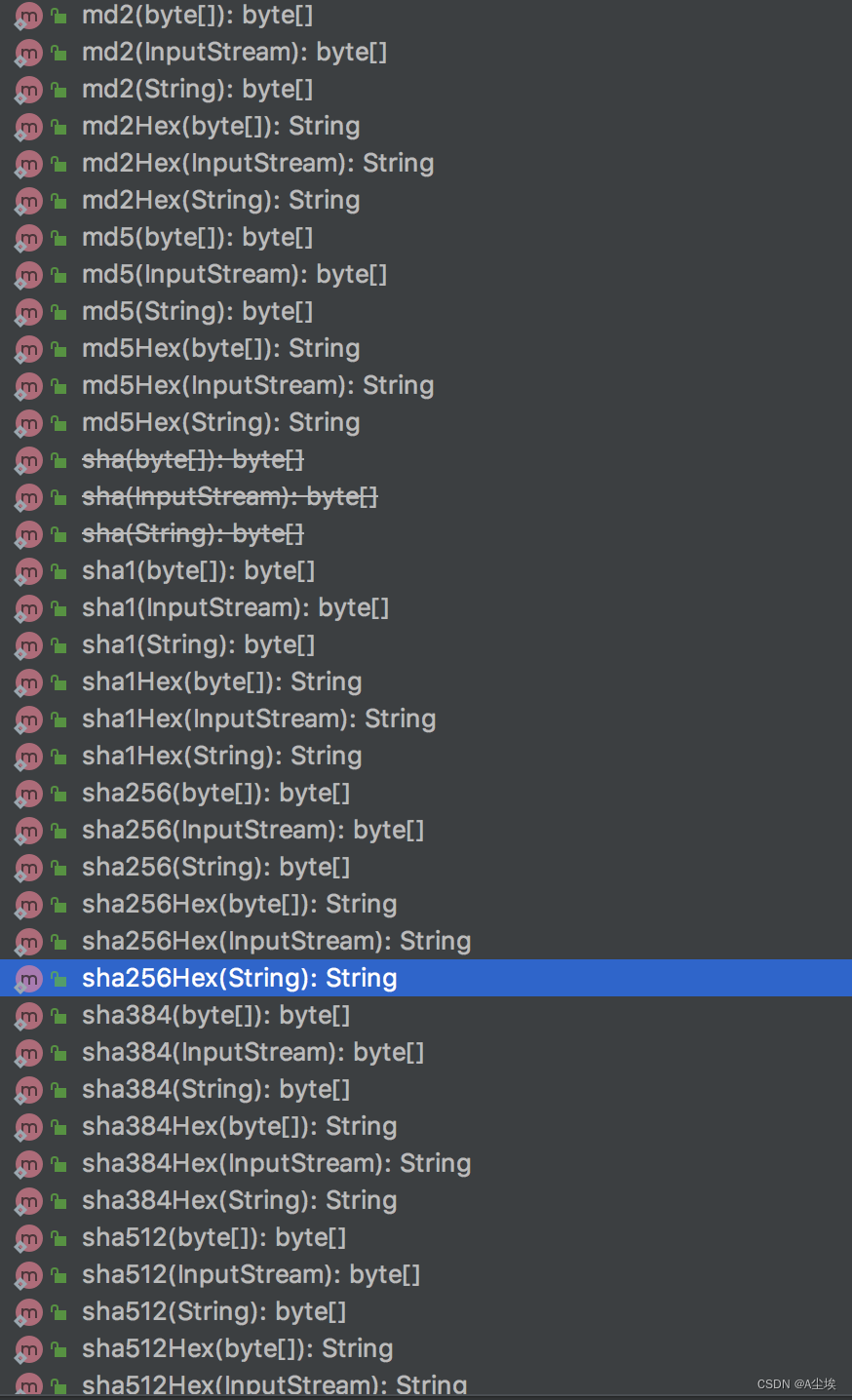
SerializationUtils
把数据进行序列化和反序列化处理
传统的做法是某个类实现Serializable接口,然后重新它的writeObject和readObject方法。
使用org.springframework.util包下的SerializationUtils工具类,能更轻松实现序列化和反序列化功能。
Map<String, String> map = Maps.newHashMap();
map.put("a", "1");
map.put("b", "2");
map.put("c", "3");
byte[] serialize = SerializationUtils.serialize(map);
Object deserialize = SerializationUtils.deserialize(serialize);
System.out.println(deserialize);
HttpStatus
在代码中定义http的返回码,比如:接口正常返回200,异常返回500,接口找不到返回404,接口不可用返回502等。
private int SUCCESS_CODE = 200;
private int ERROR_CODE = 500;
private int NOT_FOUND_CODE = 404;
其实org.springframework.http包下的HttpStatus枚举,或者org.apache.http包下的HttpStatus接口,已经把常用的http返回码给我们定义好了,直接拿来用就可以了
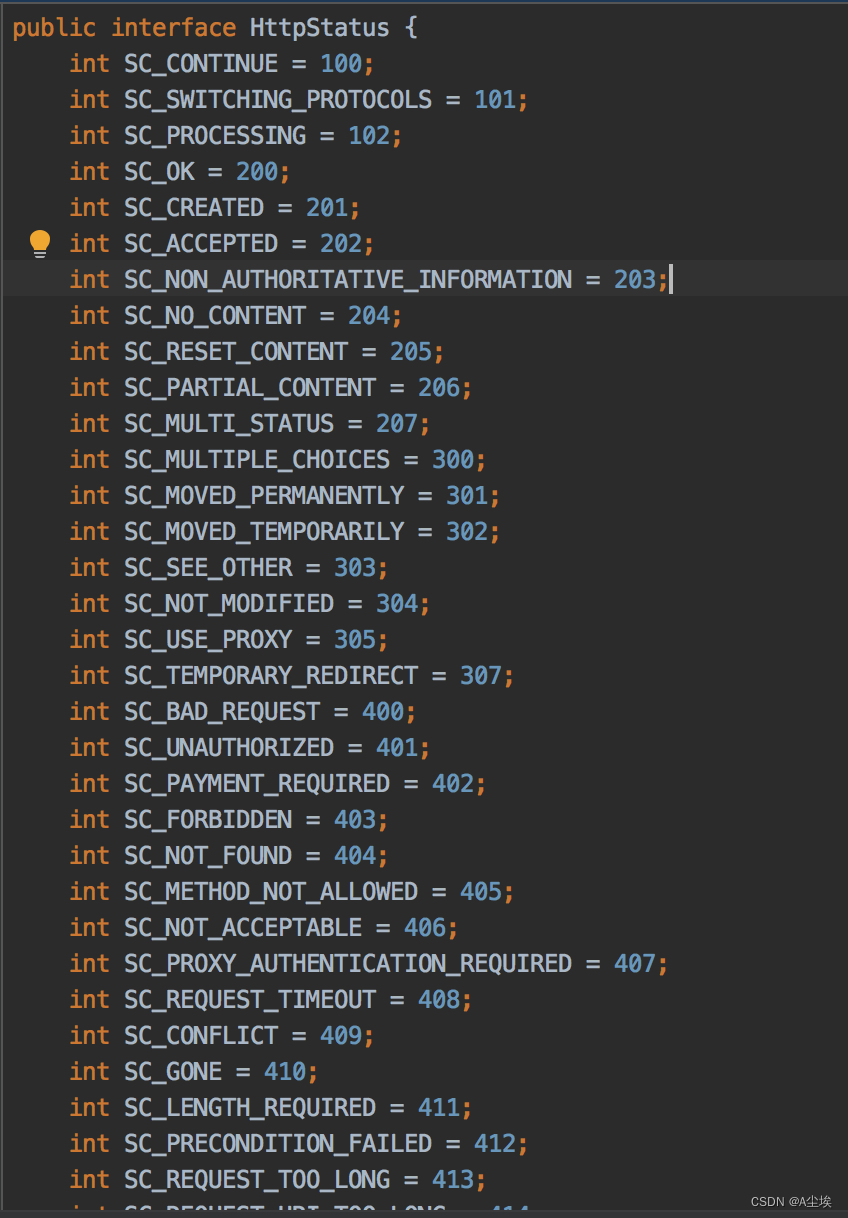







坐216路公交车去买3.5元一斤的西红柿——C++中如何表达各种数值数据 3.3 数值数据类型)



)







